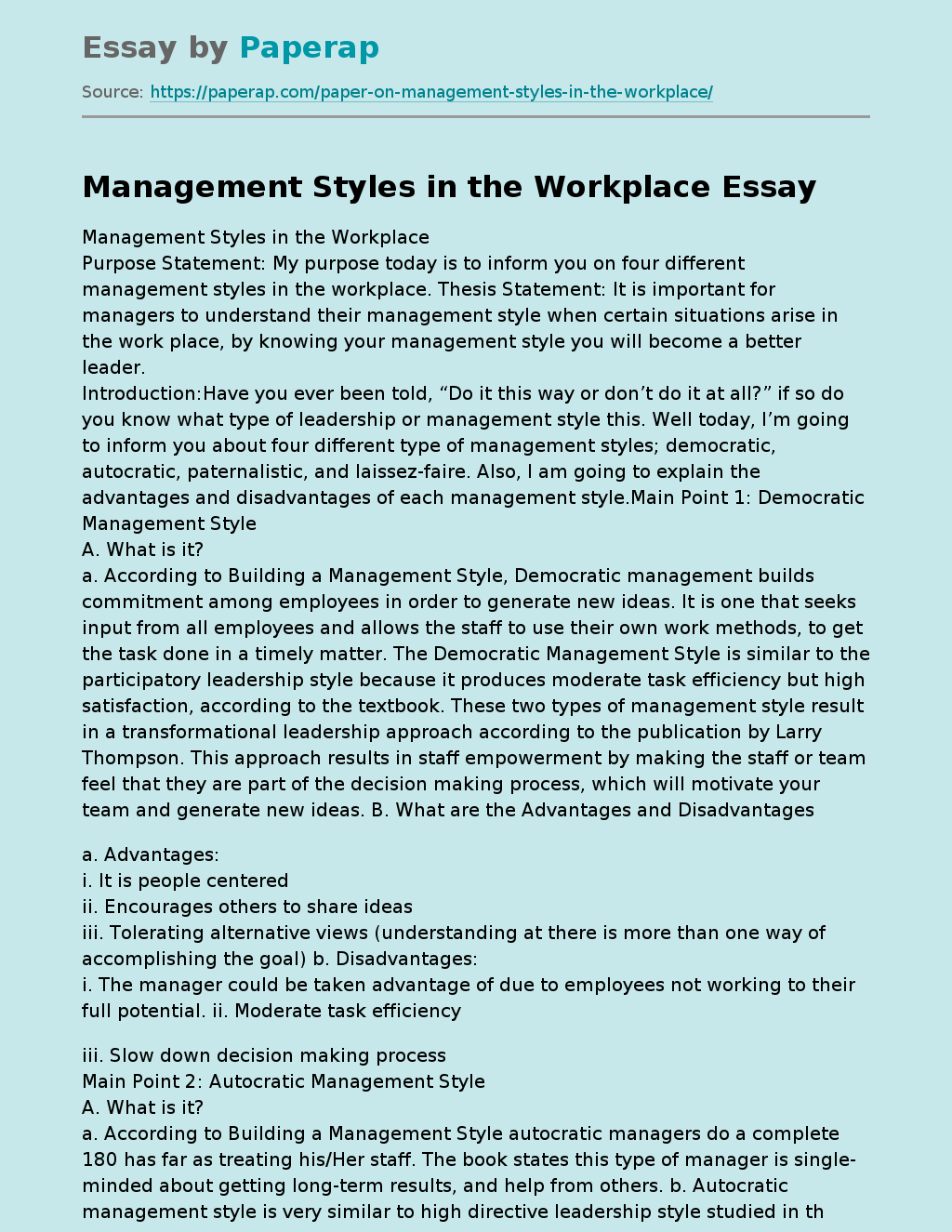Management Styles in the Workplace
Purpose Statement: My purpose today is to inform you on four different management styles in the workplace. Thesis Statement: It is important for managers to understand their management style when certain situations arise in the work place, by knowing your management style you will become a better leader.
Well today, I’m going to inform you about four different type of management styles; democratic, autocratic, paternalistic, and laissez-faire. Also, I am going to explain the advantages and disadvantages of each management style.Main Point 1: Democratic Management Style
A. What is it?
a. According to Building a Management Style, Democratic management builds commitment among employees in order to generate new ideas. It is one that seeks input from all employees and allows the staff to use their own work methods, to get the task done in a timely matter.
The Democratic Management Style is similar to the participatory leadership style because it produces moderate task efficiency but high satisfaction, according to the textbook. These two types of management style result in a transformational leadership approach according to the publication by Larry Thompson. This approach results in staff empowerment by making the staff or team feel that they are part of the decision making process, which will motivate your team and generate new ideas. B. What are the Advantages and Disadvantages
a. Advantages:
i. It is people centered
ii. Encourages others to share ideas
iii. Tolerating alternative views (understanding at there is more than one way of accomplishing the goal) b. Disadvantages:
i. The manager could be taken advantage of due to employees not working to their full potential. ii. Moderate task efficiency
Main Point 2: Autocratic Management Style
A. What is it?
a. According to Building a Management Style autocratic managers do a complete 180 has far as treating his/Her staff. The book states this type of manager is single-minded about getting long-term results, and help from others. b. Autocratic management style is very similar to high directive leadership style studied in the textbook, such as; productivity is high, with little concern for people and their satisfaction level. The autocratic management style only offers one-way communication, and that is through the leader. This type of management style falls into the transactional theory according to the publication by Larry Thompson. B. What are the Advantages and the Disadvantages?a. Advantages:
i. Although this type of management style seems pretty forceful there are many advantages. According to Managementstyle.org a few of the advantages are: 1. Instructions are forceful,2. can make fast decisions,
3. less unexpected side track situations due to lack of communication. b. Disadvantages:
i. With such a Hitler style management approach there will disadvantages to using the autocratic management style, according to Managementstyle.org, such as: 1. The staff may feel useless as they are not consulted 2. Input from the staff is not allowed 3. Staff waiting on instructions (will cause delays) Main Point 3: Paternalistic Management Style
A. What is it?
a. According to learningmanagement2.com the paternalistic management style is combination of both democratic and autocratic management styles. Paternalistic managers will ask for the staff views and opinions, which allows them to feel involved, but in the end the manager will make the finial decision. b. According to Dr. Daniel Theyagu, who is a
a. Laissez Faire Management style is also known as negligent leadership style in the textbook. According to the business dictionary website, laissez-faire management styles is a non-authoritarian approach to management. This type of manager feels that or “believes that people will excel when they are left alone to respond to their responsibilities and obligations in their own ways. B. What are the advantages and disadvantages?a. Advantages: According to about.com this type of management can be very effect if: i. When leaders are still there for consultation and feedback ii. Members are able to work alone and still be motivated iii. If Members are highly skilled, they do not need to wait on management to tell them how to complete the task. b. Disadvantages: In most cases the disadvantages out way the advantages because i. The lack of guidance may leave the staff feeling neglected. ii. According to the textbook, leader take no part in the decision-making process and offers little advice or direction. Conclusion:
We are all managers of your own lives, but one day we will be leaders of others. Democratic management style allows others to take part in the decision-making process. Autocratic management style leaders make decisions
Management Styles in the Workplace. (2016, Oct 10). Retrieved from https://paperap.com/paper-on-management-styles-in-the-workplace/
